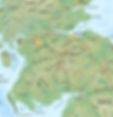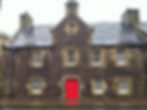The Unique & Early History of Biggar: Then & Now
- Luke
- Mar 3
- 5 min read
It's a well-known fact that both Biggar and just Scotland in its entirety are places steeped in history.
History that spans across thousands of years... From the ancient Mesolithic era,
to its early modern period. This variety of significant historical periods within Biggar and its surrounding area creates an atmosphere perfectly fit for travellers looking to indulge in the historical aspect of Scotland. Whether you're a hardcore history buff or just a tourist looking to expand your knowledge, this small town of Biggar is perfect for you!
Earliest Evidence of Humans in Scotland.
Biggar is a town steeped in history that spans thousands of years...
But a little lesser-known fact is that Biggar is home to the earliest known presence
of humans in Scotland. This was discovered between 2005 and 2009 when archaeologists unearthed a site of 5000 flint tools that dated back 14,000 years (Mesolithic era). This was found at Howburn Farm, just 4 miles north of Biggar. Prior to this find, the earliest known evidence of humans in Scotland dated back 13,000 years ago, so this new discovery pushed the timeline back 1,000 years!

According to archaeologists, these tools were likely left behind by hunters who came to Scotland in hopes of finding better hunting grounds, with the animals they were likely hunting being reindeer.
and wild horses. During this time period, Britain and Europe were actually connected. So these new inhabitants of Scotland likely came from places like Denmark, Germany, and land that is now submerged under the North Sea.
If this sounds like something of interest to you... Then visit Biggar and Upper Clydesdale Museum, found at the north end of Biggar High Street. This museum might be just the place for you! Not only does this museum actually have the Mesolithic-dated tools unearthed between 2005 and 2009,
but it also has a wide variety of knowledge and artefacts from and about earlier periods
in Scotland's history.
Biggar During The Roman Empire.
While the small town of Biggar may not have been heavily influenced by the Romans...
A mark was still somewhat left both here and in the surrounding area.
During the reign of the Roman Empire, the Romans trekked through a large portion of Britain.
but were unable to fully maintain the land north of Hadrian's Wall, which spanned from Wallsend, Newcastle upon Tyne, to Bowness-on-Solway, Cumbria.
Although the Romans were met with difficulty in this area, they were still able to move past the wall, build roads, and set up temporary forts. It's well understood that a significant portion of the A702 road found in Scotland actually follows the path of an earlier Roman road. The A702 is a road that starts near Abington, spans up through Biggar, and ends just outside Edinburgh.

When it comes to Roman forts in Biggar, the evidence is lacking, but when it comes to Roman forts
In the surrounding area, we can point to a couple of examples:
Crawford Fort
The remains of Crawford Fort are found along the A702, just 15 miles south of Biggar.
This fort was inhabited by the Romans on 3 separate occasions. The first time was during 80-87 AD, the second was in 140-155 AD, and the last time was in 155-170 AD. Each time they stayed here,
they dismantled the fort in hopes of leaving no remnants of their stay behind.
This fort was the perfect rest stop before continuing their journey up the A702.
Lyne Fort
Lyne Roman fort is again found just 13 minutes from Biggar. It was set up as a permanent fort and was likely occupied in the 140s to 150s AD. This was during the Antonine period of the Roman Empire. The Romans had picked a scenic location for a build spot, as this fort overlooked the stream
of the Lyne Water. This large fort was excavated in the year 1901. Since then, archaeologists have discovered evidence of red sandstone buildings that once sat within this fort.
Just like many Roman forts found in Scotland... Very little of the fort actually remains.
It's usually just the layout and earthly mounds within and around the fort that give us a glimpse into the ancient past of the Scottish and Roman link. This applies to the forts mentioned above.
Medieval Scotland – The Rise of a Kingdom.
It was during Scotland's medieval era when Biggar first appeared as a burgh of barony in 1451.
However, information on the town was first mentioned around 300 centuries prior to this in 1164,
where records mention a man named Robert, who turned out to be the first parson of Biggar.
Biggar Kirk also appears to be one of the oldest buildings in Biggar, with it first being built
in the 12th century, before later being rebuilt in 1545.

Even the layout of Biggar High Street today still gives us a glimpse into its medieval past.
Like its wide street layout, built for the purpose of holding markets, fairs, and events.
Or it's old and unique architecture found dotted along the street. A good example of this is a building locally known as "the oldest house in Biggar." This is a home found on the Biggar high street, just a 2-minute walk from Cadgers brig. A prominent feature of this building is the tiny front door found right on the high street! Nowadays it sits as a home, but years prior, it actually functioned as an inn.
with it also historically being used as a place for officers from the retreating Jacobite army
to seek refuge in, during the year 1746.

During this medieval era of Biggar's history, a lot of local legends and tales were spread.
It's widely believed that one of Scotland's most famous historical figures once spent time
here in Biggar. According to local legend, Sir William Wallace once disguised himself as a pedlar and lingered around Cadgers Brig (a small historical bridge at the bottom of Biggar) whilst on somewhat of a secret mission in Biggar. He was there solely to spy on the English army, who at the time
had set up camp in Biggar. Though little physical evidence supports this story, it adds a layer of intrigue to Biggar’s already fascinating history.

Stay at Our B&B and Immerse Yourself in History
For the history lovers out there, Biggar is an ideal place to explore and venture through
Scotland’s rich past. All whilst finding comfort in a cosy and welcoming place to rest and relax in.
Our B&B, located in a renovated historic corn mill, offers our guests a unique blend of modern comfort alongside the vintage charm of the building. With the original waterwheel gearings dating back centuries, found still intact and on show in the breakfast lounge/public area!
Our accommodation in Biggar aims to provide you with an authentic experience that will be sure to connect you with the rich heritage of the area. After a day of visiting ancient sites, Roman roads,
and medieval landmarks, seek refuge in our fully equipped and cosy suites.
Whether you're delving into Scotland’s never-ending past of history or simply just enjoying the scenic Scottish countryside, Biggar is the perfect destination for all walks of people.
Book your stay directly through us for the best rates!
Click here to have a browse through our rooms and see what suits you best.
